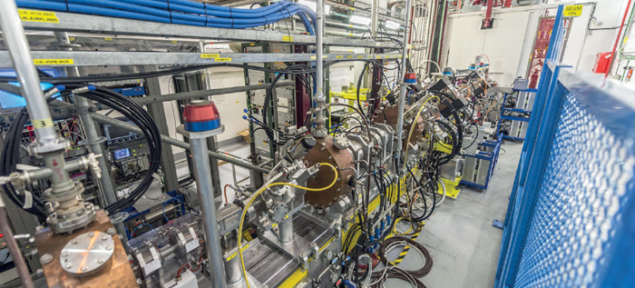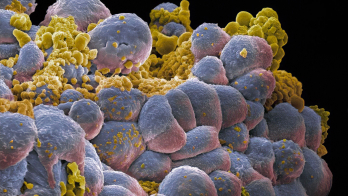
On 14 November, a beam of negative hydrogen ions was successfully accelerated for the first time to 3 MeV in Linac4. This marked the start of a two-year commissioning phase for the new linear accelerator that will replace Linac2 as the low-energy injector in CERN’s accelerator complex. When this chain of accelerators that ultimately serves the LHC is in operation, the negative hydrogen ions will be stripped of their two electrons and converted into protons at injection into the Proton Synchrotron Booster.
In the first months of 2013, the Linac4 collaboration commissioned the radio-frequency quadrupole (RFQ) at a dedicated test stand. The 1.5-tonne RFQ, constructed completely at CERN, sits at the start of the Linac4 beam line and takes the beam from 45 keV to 3 MeV in just 3 m.
During the summer, the team moved the RFQ, the medium-energy beam transport (MEBT) line and the diagnostic line to their final location in the Linac4 tunnel. In parallel, a new negative-hydrogen-ion source was assembled, installed and successfully commissioned in the tunnel. After a short RF commissioning period, the beam was accelerated to 3 MeV and transported to the beam dump at the end of the diagnostic line.
By the end of 2013 – only a few months into installation – most of the Linac4 infrastructure was in place. Not only have the RFQ and MEBT, with its fast beam chopper, been placed in their final locations, the majority of the RF klystrons on the surface have also been installed. In parallel, a second-generation negative-hydrogen-ion source has been commissioned on the test stand, delivering a beam in excess of 50 mA just before the end of the year.
Once commissioning to 3 MeV is completed in February, three more RF accelerating sections will be installed progressively to take the ion beam to its final energy. Drift tube linacs (DTL) will take the beam to 50 MeV; cell-coupled DTLs will take it to 100 MeV; and, finally, pi-mode accelerating structures will take it up to 160 MeV.








